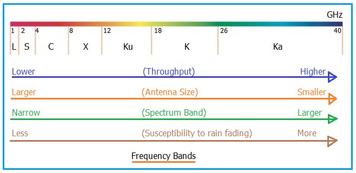
L Band: Frequency Range, Wavelength, and Applications
Explore the L band's frequency range (1-2 GHz), wavelength (15-30 cm), applications in communication, advantages, and disadvantages in various industries.
Showing 20 posts (Page 3 of 6)
Advertisement

Explore the L band's frequency range (1-2 GHz), wavelength (15-30 cm), applications in communication, advantages, and disadvantages in various industries.

Explore a comprehensive list of LoRa channels, mapping frequency to channel number. Optimize your LoRa devices by understanding these settings.

Explore LoRa frequencies in the US (902-928 MHz), data rates, Tx power (EIRP) for IoT applications in smart cities, industrial monitoring, and agriculture.

Explore the differences between low-pass and band-pass sampling techniques, including Nyquist criteria, anti-aliasing filters, and frequency translation.
Understand the relationship between LTE bandwidth, sampling frequency, and resource blocks. Includes a table of common LTE configurations.

Convert LTE EARFCN to downlink and uplink frequencies. This calculator simplifies RF planning in LTE networks using the EARFCN standard.
Understand the LTE EARFCN equation and how it relates to frequency. Includes downlink/uplink calculations and a conversion table.

Explore the pros and cons of MFSK (Multiple Frequency Shift Keying), including benefits like reduced error rates and drawbacks like complex tuning.

Explore the differences between MEMS and crystal oscillators in terms of structure, working principle, and characteristics.

Explore the pros and cons of microwave frequency, including bandwidth, antenna size, line-of-sight limitations, and environmental factors.

Explore the differences between Microwave, Terahertz, and Free Space Optics (FSO) technologies based on frequency, bandwidth, power, and applications.
Overview of millimeter wave (mmWave) frequency bands, including Q, U, V, E, W, F, D, and G bands, with their respective frequency ranges.

Understand the distinctions between millimeter wave (mmWave) and microwave frequencies, including applications, bandwidths, resolution, and advantages.
Overview of NFC (Near Field Communication) technology, including its operating frequency (13.56 MHz), specifications, and related technologies.

Explore Oven Controlled Crystal Oscillators (OCXOs), their operation, and the differences between AT, IT, and SC cut crystals.
Explore the distinctions between OCXO and OCSO oscillators, including their applications, frequency stability, and phase noise performance, to help you choose the right one.

Explore different oscillator types including Wein Bridge, Colpitts, Clapp, Hartley, and crystal oscillators. Learn about their circuits and frequency equations.

Explore the definitions, examples, and distinctions between periodic and aperiodic signals in communication systems and signal processing.

Calculate phase shift or phase angle using frequency and time delay with our online calculator. Understand the phase shift formula for degrees and radians.
Explore the distinctions between pitch and frequency in audio, highlighting their subjective vs. objective nature and non-linear relationship.
Advertisement